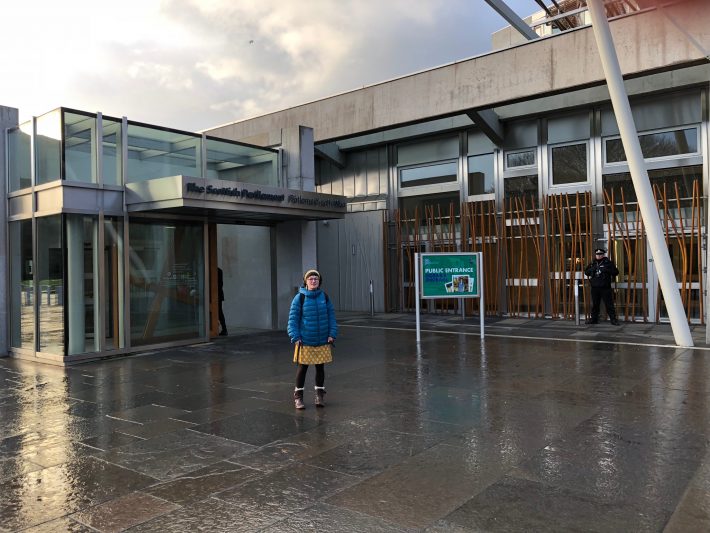Understanding environmental policy in Scotland
In December 2018 Dr Magda Chudzinska took part in the BES Policy Shadowing scheme in Scotland. Read her blog to find out how she got on and what she learned.

Environmental policy is shaped and influenced by many interest groups, and scientists are just one of them. To make my applied marine project even more applied (I’m modelling the movement of harbour seals in Scottish waters and want my model to be used to help study the effect of offshore constructions on populations of harbour seals), I decided to go for the BES’s 2018 Parliamentary Shadowing scheme to understand how environmental policy is shaped at the very top of the decision-making chain in Scotland. After being chosen as the successful candidate, I followed for two days, the Cabinet Secretary for Environment, Climate Change and Land Reform Roseanna Cunningham MSP and Minister for Rural Affairs and the Natural Environment, Mairi Gougeon MSP.
Before I took part in the scheme, politicians were for me a bit like elves for Icelanders. You know they exist, you heard that somebody saw somebody who saw them, but you find it difficult to understand what they really do and how. What I did not expect was how open to the public and ‘normal’ members of the Scottish parliament are, as well as those working with them.
You also have no doubts that you have entered the Scottish Parliament – a few politicians were wearing earrings with Scottish flags, a few had their nails painted blue with a white cross, a few wore ties with the Scottish flag, and the parliamentary shop is full of Scottish goods. To my surprise, the Scottish Parliament is very gender and age-balanced. Women of various ages are represented at each level of the parliamentary ladder. This is different to my experience of academia, where men are still the dominant group at the highest levels of the hierarchy.
My two days in the parliament were very busy, probably as busy as a normal working day for the two MSPs I followed. Or, probably, even busier than usual, as the end of 2018 was a ‘hot and hectic’ Brexit time. There were barely any free slots in Roseanna’s and Mairi’s calendars and parliament was a bustling place, full of phone calls, footsteps and parliamentary sessions playing on various screens.
Brexit was the dominant topic on the agenda for most parliamentary meetings that I attended. For instance, I joined the Environment, Climate Change and Land Reform Committee ‘EU exit and environment’ session where the two Cabinet Secretaries Roseanna Cunningham MSP and Fergus Ewing MSP (Cabinet Secretary for the Rural Economy), were answering questions raised by committee members about post-Brexit environmental policy and issues. I am not going to elaborate on all that I heard, as this would require a separate book, but I would like to highlight a few points that caught my attention particularly as they may affect me directly:
- Most scientific projects are based on multidisciplinary and international cooperation. Replacement funding has not even been guaranteed for current EU-funded projects and actions, including the Horizon 2020 scheme, which constitutes 10% of all research funding in Scotland. What happens after 2020 is unknown. Most likely, Brexit will cause reductions in networking and cooperation in science as the UK may not be able to participate in EU-funded and centred global projects. This will also affect ongoing EU-funded long-term projects.
- Brexit will, most likely, cause a decrease in environmental standards as it is not likely that current EU standards will be held by the UK, even if Scotland plans to do so.
- Brexit is extra work on top of, already very busy, everyday work of the Scottish Government. New rules and regulations must be thoroughly prepared and studied for all possible Brexit scenarios even without knowing which scenario will happen, if any.
- Brexit means redoing 40-45 000 certificates for exported food items, a lot.
Although the Cabinet Secretary had a packed schedule during the time I shadowed her, I was lucky to get some one to one time with her. As environmental decisions are based on the interests of a range of stakeholders, I asked her how these interests are weighed up. Not surprisingly, there is no simple weighting system and it is evaluated separately for each decision.
The loudest voices do not necessarily represent the most important or largest interest groups, and it is important to make sure that all voices are heard and considered. Also, the views of some parts of society may not be represented in some of the discourse. From time to time, where there is no consensus, the Scottish Government may make a decision that is perceived as unpopular/riskier to some of the stakeholders because it does not represent their point of view/interest.
An important lesson that I took away is that although science plays an important role in shaping environmental decisions and government frequently seeks scientific advice, to be heard it is better as a scientist to come forward and try to deliver your message in the most appropriate form i.e. short and to the point.
I was also surprised by the variety of environmental topics Government covers, to mention just few: fox-hunting, porpoises, single use plastic, marine protected areas, air quality strategy, flooding strategy, animal health and welfare, geese management, beavers, wild cats. It humbled me and showed that my project and work is a drop in the ocean of environmental issues. If I want to be heard, I really have to listen first…
Like what we stand for?
Support our mission and help develop the next generation of ecologists by donating to the British Ecological Society.